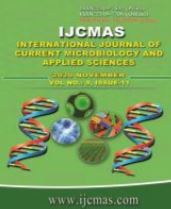


 National Academy of Agricultural Sciences (NAAS)
National Academy of Agricultural Sciences (NAAS)

|
PRINT ISSN : 2319-7692
Online ISSN : 2319-7706 Issues : 12 per year Publisher : Excellent Publishers Email : editorijcmas@gmail.com / submit@ijcmas.com Editor-in-chief: Dr.M.Prakash Index Copernicus ICV 2018: 95.39 NAAS RATING 2020: 5.38 |
Zinc solubilizing ability of bacterial isolates was evaluated by using insoluble Zn compound (ZnO) in both plate and broth media assays. The total of 40 bacterial isolates were obtained from Soil Microbiology Laboratory, Department of Soil Science & Agricultural Chemistry, Institute of Agricultural Sciences, Banaras Hindu University, Varanasi, India of which 21 showed ability of Zn solubilization on Bunt and Rovira media supplemented with 0.1% Zn source (ZnO). Remaining 19 bacterial isolates were unable to form halo zones. The diameter of halo zones formed by the bacterial isolates ranged from 0.50 to 2.7 cm. Three isolates 12, 28 and 35 could form halo zone with diameter ≥ 2.5 cm. These three bacterial isolates were named as ZSB1, ZSB2 and ZSB3 respectively, and were selected for determining their zinc solubilizing capacity in broth culture assay by using AAS. In broth assay, maximum solubilization of zinc in the medium was observed on 21st day and was in the range of 29.68μg /mL to 36.08 μg /mL. Bacterial isolate ZSB2 exhibited the maximum solubilization (36.08 μg mL−1) of zinc, while the minimum (29.68 μg mL−1) quantity of solubilized Zn was obtained with the inoculation of ZSB3. Thus, the quantity of Zn solubilized by these three bacterial isolates was directly related to diameter of halo zone formed by them.
 |
 |
 |
 |
 |